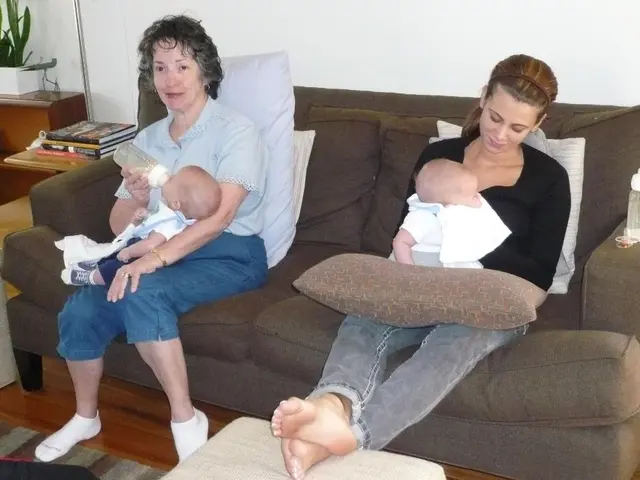Relationship Anxious Attachment: Characteristics and Triggers Uncovered
Navigating the Deeper Depths of Anxious Attachment
Are you sick and tired of feeling like you're doing everything in your power to win your partner's favor, only for them to retreat even further? Do you spend a significant amount of time worrying that you're never good enough, or that you're forever destined to walk on eggshells around them? If this sounds familiar, you're definitely not alone.
In this bold exploration, we'll delve into the complexities of anxious attachment in relationships. We'll define this attachment style, trace its origins, expose examples of its presence, and, of course, provide some realistic approaches to breaking free from its clutches. So, if you're ready to unravel the mysteries of anxious attachment, buckle up and let's dive in.
What's Your Attachment Style?
>>TAKE THE QUIZ<<
Anxious Attachment: What Is It?
Anxious attachment is one of the four primary relationship styles propounded by attachment theory. This pattern might stretch back to our infant days, evolving as we mature into adulthood. Explorations of attachment theory reveal that these styles lay down the blueprint for how we give and receive love, shaping our behaviors in adult romantic relationships.
Let's unpack the fundamentals of attachment theory.
The Core of Attachment Theory
Attachment Theory consists of four unique attachment styles in relationships. This theory articulates that these styles are born out of the interactions we have with our primary caregivers during our youth and late adolescence, with these early relationships inevitably shaping the romantic ones we'll encounter as adults.
The four attachment styles are grouped as:
- Anxious: Adults grappling with feelings of unworthiness
- Avoidant: Adults who recoil at the thought of commitment rooted in fear
- Disorganized: Adults plagued by insecurity and unpredictable behaviors
- Secure: Adults armed with a favorable self-image and open to romantic connection
The first three attachment styles (Anxious, Avoidant, and Disorganized) are considered insecure styles. The fourth style (Secure) is the ultimate objective for many. In fact, research indicates that people with secure attachment styles tend to experience the highest level of happiness in their relationships.
Now, allow us to focus on the intricacies of anxious attachment and its underlying causes.
What Sparks Anxious Attachment?
The prevailing wisdom in the field casts our experiences, particularly during our infancy and early childhood, as significant factors influencing our attachment style. The interplay between our caregivers and ourselves during these decisive years often has a lasting impact on the development of our attachment style.
Anxious attachment often materializes from an uncertain or anxious parent. Parents plagued with this attachment style might have experienced this pattern themselves in their early years. These parents may have grown up without their own emotional needs being met, which left them feeling hollow and dissatisfied. As they transition into parenthood, they may cling to their child, in an attempt to fill the emotional void gnawing within them.
As a consequence, we find ourselves ensnared in what is often referred to as the generational cycle of anxious attachment. An anxious parent may shower their child with more affection than an avoidant or dismissive parent is willing or able to provide. As the child matures, they may grow up harboring an emotional confusion about whether they can truly depend on others. As they enter their romantic relationships and start families of their own, this lack of assurance continues to plague their interactions, setting the stage for a seemingly never-ending cycle.
On occasion, we find instances where the opposite occurs. A child may demand more affection than a parent is willing or able to provide, eliciting an insecurity within the youngster that drives them to search for a new caregiver or "parent figure" in their adult romantic partners.
With that, let's delve into the specific traits associated with anxious attachment.
Characteristics of Anxious Attachment
If you're constantly walking on eggshells or pursuing an untouchable partner, it could be that you're wrestling with anxious attachment. Anxious attachment among adults, or what I'll refer to as Open-Hearted attachment, is characterized by a deep-seated fear of unworthiness.
Anxious attachment normally arises from an underlying fear of abandonment and rejection. It often manifests itself in relationships through a fear of never being good enough and clingy behavior.
Intrigued to learn more about Open Hearts and their chaotic attachment habits? Let's break down some of the traits they might exhibit:
- You regularly succumb to feelings of jealousy, stemming from your insecurity
- You have grown accustomed to sparse love and affection in your relationships
- You tend to overcommit yourself and are constantly people-pleasing
- You feel compelled to be overly helpful in relationships, goading your partner to "need" you
- You shoulder the bulk of the responsibility, guilt, and blame in relationships
- You struggle with low self-esteem and chronic feelings of unworthiness
Plagued by these feelings of insecurity, you may believe you don't deserve love, but rather have to earn and strive for it. This leaves you prone to seeking out challenging partners who force you to work diligently for their affection. On the flip side, if your partner showers you with love and affection, you may perceive this as monotonous and feel the urge to seek out new partners.
Now that we've painted a vivid picture of anxious attachment as an individual, let's delve into the far-reaching consequences it has on our relationships.
What's Your Attachment Style?
>>TAKE THE QUIZ<<
Anxious Attachment: Its Impact on Relationships
Our attachment styles have an undeniable bearing on our relationships. Attachment styles serve as excellent indicators of how we handle emotional intimacy, so those with different styles approach intimate encounters in significantly varied ways. In this section, we'll examine:
- How anxious attachment affects relationships
- Examples of anxious attachment in romantic partnerships
- Proven strategies to navigate relationships with anxious attachment
How Anxious Attachment Plays Out in Relationships
In a romantic relationship, many Open Hearts go above and beyond to make themselves indispensable to their partners. Their thought process seems to be "If they need me, they won't leave me." The desire to feel needed stems from their need for reassurance and a sense of connection with their partner. However, this tactic often backfires.
When faced with the fruits of their labor, the Open Heart often wonders whether their partner truly loves them for who they are. To release themselves from this complex psychological bind, they must learn to prioritize their own needs and desires, while fostering a sense of trust and cooperation with their partners.
Open Hearts struggle to connect with the genuine version of themselves within their relationships, a conundrum born out of their chronic unworthiness. Insecure feelings of unworthiness commonly lead them to prioritize their potential within a relationship over its reality. Furthermore, their reluctance to expose their vulnerabilities and insecurities results in conflict, as their needs remain neglected or unarticulated.
One of the most destructive pitfalls of anxious attachment is that Open Hearts unintentionally attract partners with their own insecure attachment styles. This coupling, sometimes referred to as the anxious-avoidant trap, frequently results in a partnership between someone who is emotionally unavailable and someone who clings desperately for love. This dynamic is often characterized by anxiety, distance, and unnecessary tension.
However, it is possible to successfully establish a partnership with someone dealing with anxious attachment. To achieve this, we must arm ourselves with a working knowledge of anxious attachment trigger statements and steer clear of those that could send these individuals into a tailspin.
Anxious Attachment Trigger Statements
To nurture a relationship with someone struggling with anxious attachment, or Open Heart, it's essential to avoid triggering statements that could exacerbate their feelings of insecurity and inadequacy. Some examples include:
- "Love is not enough, but I still love you."
- "I'm sorry you feel that way."
- "I don't know what you're upset about, it's not really that big of a deal."
- "I need some time alone to think about it."
- "I don't know why I feel this way, the chemistry just doesn't work."
- Silence
To alleviate the anxiety of the Open Heart, try utilizing reassuring statements like:
- "It's okay, we'll find a way through this."
- "I want to give you a hug, it will be alright."
- "I'm not afraid of your feelings, I'm here to help you navigate them."
- Empathize with their feelings and assure them that they are important to you.
- Express your willingness to help them work through their emotions. Show them that you value their feelings and strength.
Another common, triggering phrase for the Open Heart is "You're overreacting." This statement may be intended to reduce tension and anxiety, but to the Open Heart, it may come across as dismissive and disregarding.
To effectively communicate with the Open Heart, shift your focus to empathy and validation. Try saying: "Even if I can't fully understand why you're feeling this way, I know it's hard, and I'm here to support you." By acknowledging their feelings without judgment, you and your Open Heart partner can navigate conflicts more effectively.
By being mindful of your interactions with an anxious Open Heart and learning to reduce their anxiety, you'll increase your odds of success, no matter their attachment style. Just remember: Patience and understanding are crucial.
Escape the Anxious-Avoidant Trap
To break free from the anxious-avoidant trap, it's essential to understand the emotions driving the anxious Open Heart. Once you've achieved emotional proficiency, you can help them transition toward a more secure attachment style. This shift may manifest itself in recognizing your own needs and your partner's needs and working together to foster an emotionally healthy partnership.
To heal your inner child, take the following steps:
- Acknowledge and Empathize:
Understand that your inner child is hurting and validate its emotions, even if you may not be able to fully grasp them.
- Reparent Yourself:
Practice self-care, set healthy boundaries, and engage in activities that bring you genuine happiness, nurturing your inner child and fostering emotional security.
- Embrace Self-Love:
Work on developing a positive self-image and embrace your strengths and weaknesses, as this encourages you to view yourself and your inner child as worthy of love and validation.
- Communicate Openly and Honestly:
Practice open, honest communication with your partner and make your needs known, while also actively listening to their own needs.
- Seek Support:
Consider seeking professional help, in the form of therapy or support groups, as this can provide tools and strategies for healing your inner child and improving your emotional well-being.
What's Your Attachment Style?
>>TAKE THE QUIZ<<
Conclusion
Gaining insight into your attachment style and your romantic partner's attachment style can be instrumental in improving your relationship and fostering emotional security and intimacy. If you're wrestling with anxious attachment, take solace in the fact that you're not alone, and there are resources available to help you navigate the emotional complexities of relationships. Whether it's therapy, support groups, or online resources, never hesitate to reach out for assistance when needed.
Ask your questions and share your thoughts on anxious attachment in the comments below!
References
[1] "How Attachment Styles Affect Relationships." Psychology Today, Sussex Publishers, 27 Nov. 2019, https://www.psychologytoday.com/us/blog/the-science-intimacy/201911/how-attachment-styles-affect-relationships. Accessed 26 Feb. 2023.
[2] "Insecure Attachment: Overview & Types." Good Therapy, Inc., 16 Oct. 2018, https://www.goodtherapy.org/learn-about-therapy/issues/insecure-attachment. Accessed 26 Feb. 2023.
[3] "Anxious-Preoccupied Attachment." Good Therapy, Inc., 25 July 2022, https://www.goodtherapy.org/learn-about-therapy/issues/anxious-attachment. Accessed 26 Feb. 2023.
[4] "Understanding Anxious Attachment (Anxious-Preoccupied Attachment)." Psychology Today, Sussex Publishers, 24 Oct. 2017, https://www.psychologytoday.com/us/blog/the-inevitability-death/201710/understanding-anxious-attachment-anxious-preoccupied. Accessed 26 Feb. 2023.
[5] "The Impact of Early Childhood Abuse on Attachment Patterns." Child Mind Institute, 4 Feb. 2021, https://childmind.org/article/the-impact-of-early-childhood-abuse-on-attachment-patterns/. Accessed 26 Feb. 2023.
- To break free from anxious attachment's hold, it's important to understand its roots, traceable to unmet emotional needs during infancy or early childhood that led to an anxious parent-child dynamic.
- Riddled with fear of rejection and abandonment, individuals with anxious attachment often exhibit traits like chronic feelings of unworthiness, clingy behavior, and a persistent search for emotional intimacy.
- Deeply rooted insecurity stems from a desire to be needed in relationships, fueling anxiety and a compulsive need to earn love rather than simply receiving it.
- The generational cycle of anxious attachment can persist if awareness of unhealthy patterns isn't cultivated, leading to a seemingly endless series of relationships tainted by fear and insecurity.
- Recognizing the influence of attachment theory on our adult relationships, many find anonymous online forums and support groups to be extremely helpful in understanding and managing their anxiety.
- Seeking guidance from licensed mental health professionals can provide comfort and relief, fostering techniques to reduce anxiety, improve self-esteem, and nurture a sense of self-worth.
- By acknowledging and empathizing with one's inner child, setting healthy boundaries, practicing self-care, embracing self-love, and communicating openly and honestly, individuals can foster personal growth and improve their attachment style.
- Discovering self-development resources, such as online educational videos, books, and podcasts on attachment theory and romantic relationships, can offer valuable insights and practical strategies for overcoming insecurity and forging healthier connections.
- Health-and-wellness blogs often provide tips on mindfulness, meditation, and stress-reducing activities that help alleviate anxious attachment symptoms and enhance overall emotional well-being.
- Recognizing the interconnectedness of mental health, personal growth, and relationships, anxious attachment is a multifaceted issue requiring multiple avenues of exploration and assistance, ensuring a holistic approach to healing and emotional security.








